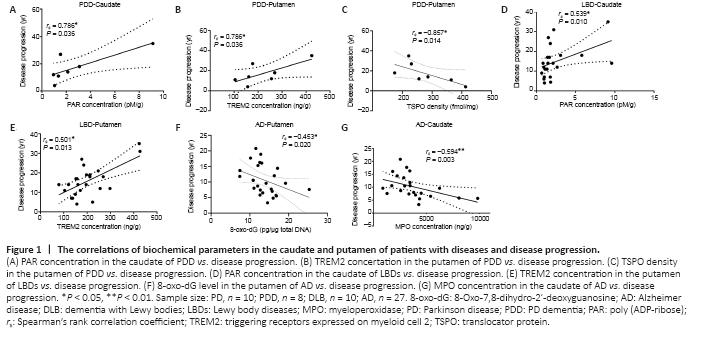神经退行性病
-
Figure 1|The correlations of biochemical parameters in the caudate and putamen of patients with diseases and disease progression.

In the Spearman correlation analyses, PDD progression positively depended on the concentration of PAR in the caudate (rs = 0.786, P = 0.036; Figure 1A). We observed a positive correlation between the TREM2 levels in the putamen of PDD patients and disease progression (rs = 0.786, P = 0.036; Figure 1B). Then we examined whether the microglial expression could be related to PDD disease progression. It appears that there was a negative correlation between TSPO levels in the putamen of the PDD group and disease progression (rs = –0.857, P = 0.014; Figure 1C). We further examined the LBD cohorts, and Spearman analyses revealed positive correlations between PAR concentration in the caudate of LBD brains and disease progression (rs = 0.539, P = 0.010; Figure 1D), as well as TREM2 expression in the putamen of LBD brains and disease progression (rs = 0.501, P = 0.013; Figure 1E). Interestingly, we found significant negative correlations between 8-oxo-dG concentration in the putamen of AD brains and disease progression (rs = –0.453, P = 0.020; Figure 1F), as well as MPO levels in the caudate of AD brains and disease progression (rs = –0.594, P = 0.003; Figure 1G).
Figure 2|The correlations of the age of onset and disease progression.

Thought-provokingly, we found that the age of onset associated with disease progression in all the neurodegenerative diseases studied, as shown in Figure 2. Spearman analyses uncovered negative correlations between the age of onset and disease progression in PD, PDD, DLB, and AD cohorts (Figure 2A–D). These results supported the hypothesis that the older the patients were, the more severe their clinical and neurophysiologic features, and that onset age mainly altered the rate of progression (Kempster et al., 2010; Pagano et al., 2016).
Figure 3|The correlations between PD stage and biochemical parameters in the putamen of patients with LBD.

LBD patients were stratified into different PD stages according to the Hoehn and Yahr scale (Hoehn and Yahr, 2001). We investigated the relationships between biochemical parameters in the striatum and PD stages in LBD groups. A significant negative correlation was observed between PD stage and PAR concentration in the putamen of LBD brains (rs = –0.462, P = 0.023; Figure 3A). Additionally, a significant positive relationship was found between PD stage and TREM2 concentration in the putamen of LBD cohorts (rs = 0.421, P = 0.036; Figure 3B), which was in agreement with the positive correlation between disease progression and TREM2 levels in the putamen of LBD cases.
Figure 4|Impact of biochemical parameters in the striatum on the AD patient survival.

In the AD cohort, Mantel-Cox analyses revealed that patients with a lower 8-oxo-dG concentration in the putamen had a significant survival advantage over those with higher 8-oxo-dG levels (P = 0.0195; Figure 4A), indicating that DNA oxidative damage in the putamen played a critical role in patient survival. Besides, there was a significant difference in survival between AD cases with a higher MPO concentration in the caudate and those with lower MPO concentration in the same brain area (P = 0.0003; Figure 4B), suggesting MPO level in the caudate is a potential positive risk factor for survival in AD patients.